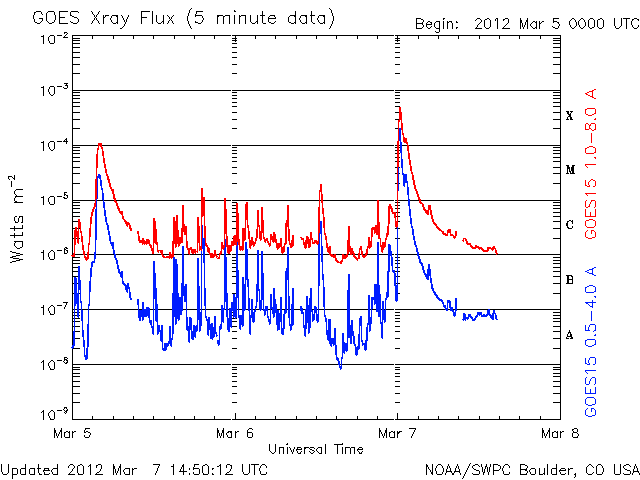Space Weather Alert - 7th March 2012
What Has Happened?
There has been an increase in geomagnetic activity over the past 24-hours resulting from activity on the Sun. This activity is expected to increase over the next 48-hours.
This morning saw an increase in geomagnetic activity due to the impact of a cloud of charged gas. This fast moving cloud, known as a Coronal Mass Ejection (CME), was ejected from the Sun on Sunday and was also associated with solar flare.
The source of this flare is a solar active region that rotated into view on March 3rd. Images of this region show a complex network of sunspots indicating a large amount of stored magnetic energy.
On Monday morning, this region erupted again with another CME and associated flare - five times larger than the Sunday event: an X1-class versus Sunday's less energetic M2-class. This CME may give the Earth a glancing blow in the next 24-hours, which could cause geomagnetic storms like those seen this morning.
And again this morning, shortly after midnight, the active region unleashed its biggest flare yet: an X5-class. (This was more than five times bigger than the X1 flare, and 25 times bigger than the M2 flare on Sunday).
See video of the event from Solar Dynamics Observatory (external link).
A CME was also observed and is heading our way with initial predictions of its arrival time ranging from late morning on 8th March to the early hours of 9th March. This CME is expected to result in magnetic storms larger than those seen today.
All this activity means there is a good chance of seeing the northern lights at higher latitudes, if the skies are clear. The hours around local midnight are best and it may be possible to see them this evening around the world but the best chance in the UK will be tomorrow night.
This active region is still growing and may produce other large flares over the coming days. As it rotates across the face of the Sun and in front of the Earth, it becomes more likely that we will be in the path of any further CMEs with resulting magnetic storms and auroral displays.
See BGS Real-time estimated Ap for global geomagnetic activity levels.
Sign-up to receive Geomagnetic Disturbance Alert emails.
Follow us on Twitter:
Follow @BGSauroraAlert for more occasional aurora alerts.
Follow @BGSspaceWeather for daily space weather forecasts.
How often does this happen?
Space weather follows a natural cycle of activity known as the solar cycle and traditionally measured by the sunspot number. After a lengthy minimum, solar activity is increasing again and in a few years time the Sun will once again be at the peak of its activity. The number of magnetic storms follows a similar cycle with its peak usually lagging behind the solar cycle by one or two years.
It is still scientifically very difficult to predict with any accuracy when a space weather event will occur and how large an impact it will have on the Earth. Research, for example funded through the UK Natural Environment Research Council, is continuing into space weather prediction.
We do know however that once a major solar eruption has occurred, that any space weather impact on the Earth will follow from hours to a few days later.
What is BGS’ Role in Monitoring and Predicting Space Weather?
The BGS Geomagnetism team measures, records, models and interprets variations in the Earth’s natural magnetic fields, across the world and over time. Our data and expertise help to develop scientific understanding of the evolution of the solid Earth and its atmospheric, ocean and space environments. We also provide geomagnetic products and services to industry and academics and we use our knowledge to inform and educate the public, government and the private sector.
The Geomagnetism team provides 24/7 monitoring of geomagnetic activity, 3-day ahead magnetic activity forecasts, and post-event analysis of storm impacts on technology, including the UK power network.
Background
One way that scientists measure the strength of solar activity is through the brightness of any solar flare that accompanies each event.
Table 1 shows the strength of the recent flare activity that caused the space weather event (highlighted), in comparison with the top 10 flares known since 1970s.
Rank |
Year/Month/Day |
X-Ray Class |
|---|---|---|
1 |
2003/11/04 |
X28+ |
2 |
2001/04/02, 1989/08/16 |
X20.0 |
3 |
2003/10/28 |
X17.2 |
4 |
2005/09/07 |
X17 |
5 |
1989/03/06, 1978/07/11 |
X15.0 |
6 |
2001/04/15 |
X14.4 |
7 |
1984/04/24, 1989/10/19 |
X13.0 |
8 |
1982/12/15 |
X12.9 |
9 |
1982/06/06, 1991/06/01, 1991/06/04, 1991/06/06, 1991/06/11, 1991/06/15 |
X12.0 |
10 |
1982/12/17, 1984/05/20 |
X10.1 |
=52 |
2003/10/23, 2005/9/8, 2012/03/07 |
X5.4 |
Rank |
Date |
Peak Rate-of-Change (nT/min) |
|---|---|---|
1 |
13th March 1989 |
1079.6 |
2 |
8th November 1991 |
804.1 |
3 |
30th October 2003 |
656.5 |
4 |
21 October 1989 |
618.6 |
5 |
1st November 1991 |
515.2 |
Glossary
- BGS
- The British Geological Survey is one of the Natural Environment Research Council's Research Centres.
CME or Coronal Mass Ejection- The eruption of a portion of the outer atmosphere of the Sun into space, caused by rapid changes in its magnetic field. Often occurs along with a solar flare.
- Coronal Hole
- A region in the Sun’s outer atmosphere (corona) where hot material can flow unrestrained by its magnetic fields out into space.
- Flare
- Energy released by the explosive reorganisation of magnetic fields within the Sun's atmosphere.
- High Speed Stream
- A fast moving stream of solar wind, responsible for magnetic storms.
- Magnetogram
- The variation, minute by minute, of the strength and direction of the Earth’s magnetic field. Measured in units of nano-Tesla (for the strength of the field) or in degrees (direction of the field).
Solar Wind- The ever-present expansion of the Sun’s hot outer atmosphere into the solar system, which carries space weather within it.
Sunspot- A region of intense magnetic field in the Sun's visible outer atmosphere often associated with flares and CMEs.




